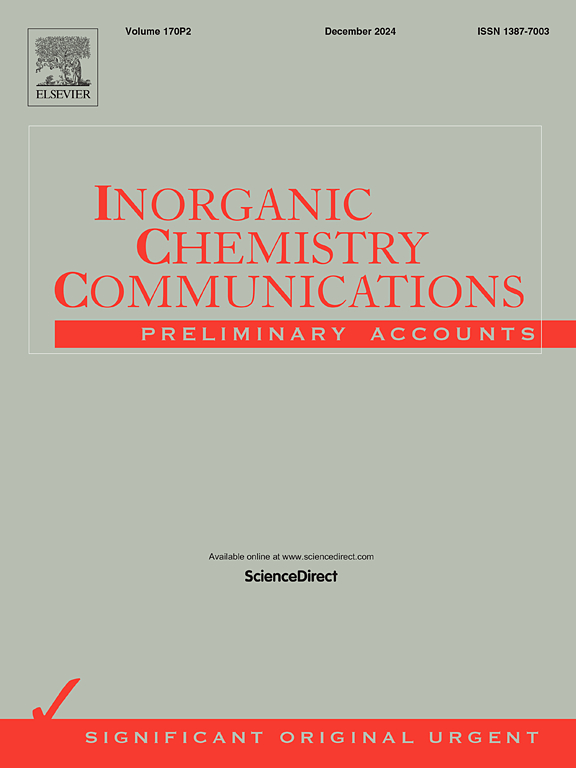Characterization and cytotoxicity of nanoceria phytosynthesized using Eucalyptus camaldulensis bark extract
IF 4.4
3区 化学
Q1 CHEMISTRY, INORGANIC & NUCLEAR
引用次数: 0
Abstract
Cancer, a complex group of diseases characterized by uncontrolled cell growth, poses a significant global health risk. In the context of the high occurrence of breast cancer (BC) in women, conventional chemotherapeutic agents, although effective, frequently bring about challenges such as resistance and recurrence. Nanotechnology is emerging as a promising approach, with attention focused on cerium oxide nanoparticles (CNPs). CNPs possess distinctive characteristics such as antioxidant activity, the ability to transition between Ce3+ and Ce4+ oxidation states, and biocompatibility with living systems. This study introduces a novel phytosynthesis method using Eucalyptus camaldulensis bark extract to synthesize CNPs, emphasizing environmentally friendly methods. Characterization techniques including Fourier transform infrared spectroscopy (FTIR), Powder X-ray diffraction (XRD), Scanning electron microscopy (SEM), energy-dispersive X-ray spectroscopy (EDX), Transmission electron microscopy (TEM), Diffuse Reflectance (DR) were used to elemental, structural, and morphological properties of synthesized CNPs. Results have shown the successful synthesis of CNPs having cubic fluorite structure with a space group of Fm3m (225) and a crystallite size of 11.2 nm based on XRD characterization. FTIR and EDX have confirmed the elemental analysis of CNPs and the presence of extracted biomolecules during the synthesis process. SEM and TEM images revealed the morphology of the phytosynthesized CNPs as sphere-like, with a size of 2 to 10 nm. Finally, cytotoxicity by MTT assay and uptake of these CNPs on MCF-7 cells demonstrates successful uptake and their potential to inhibit these cancerous cells. The protective effect of CNPs on normal cells was further investigated using a ROS assay on the MCF10A cell line. Furthermore, the catalase-mimic (CAT-mimic) activity of phytosynthesized CNPs was assessed by a commercial CAT-mimic kit assay.

桉树皮提取物合成纳米虫的特性及细胞毒性研究
癌症是一组复杂的疾病,其特征是细胞生长不受控制,对全球健康构成重大风险。在女性乳腺癌(BC)高发的背景下,传统化疗药物虽然有效,但经常带来耐药和复发等挑战。纳米技术作为一种有前途的方法正在兴起,人们的注意力集中在氧化铈纳米颗粒(CNPs)上。CNPs具有独特的特性,如抗氧化活性,Ce3+和Ce4+氧化态之间的转换能力,以及与生命系统的生物相容性。本研究介绍了一种利用桉树皮提取物合成CNPs的植物合成新方法,强调环保方法。利用傅里叶变换红外光谱(FTIR)、粉末x射线衍射(XRD)、扫描电子显微镜(SEM)、能量色散x射线光谱(EDX)、透射电子显微镜(TEM)、漫反射(DR)等表征技术对合成的CNPs进行了元素、结构和形态表征。结果表明,成功合成的CNPs具有立方萤石结构,其空间基为Fm3m (225), XRD表征结果表明其晶粒尺寸为11.2 nm。FTIR和EDX证实了CNPs的元素分析和在合成过程中提取的生物分子的存在。SEM和TEM图像显示,植物合成的CNPs形貌为球形,尺寸为2 ~ 10 nm。最后,通过MTT试验和MCF-7细胞对这些CNPs的摄取,细胞毒性证明了这些CNPs的成功摄取及其抑制这些癌细胞的潜力。通过对MCF10A细胞系进行ROS实验,进一步研究了CNPs对正常细胞的保护作用。此外,植物合成CNPs的过氧化氢酶模拟(CAT-mimic)活性通过商业化的CAT-mimic试剂盒检测进行评估。
本文章由计算机程序翻译,如有差异,请以英文原文为准。
求助全文
约1分钟内获得全文
求助全文
来源期刊

Inorganic Chemistry Communications
化学-无机化学与核化学
CiteScore
5.50
自引率
7.90%
发文量
1013
审稿时长
53 days
期刊介绍:
Launched in January 1998, Inorganic Chemistry Communications is an international journal dedicated to the rapid publication of short communications in the major areas of inorganic, organometallic and supramolecular chemistry. Topics include synthetic and reaction chemistry, kinetics and mechanisms of reactions, bioinorganic chemistry, photochemistry and the use of metal and organometallic compounds in stoichiometric and catalytic synthesis or organic compounds.
 求助内容:
求助内容: 应助结果提醒方式:
应助结果提醒方式:


